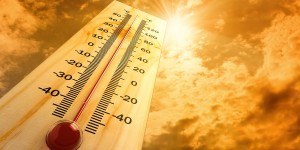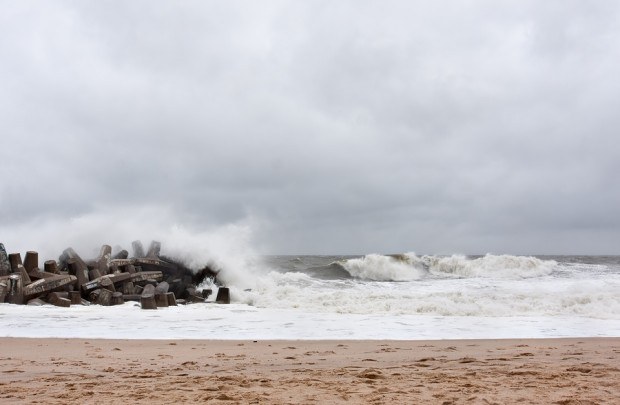The 2013 Atlantic hurricane season is humbling forecasters by shaping up as the first in almost two decades without a major storm, confounding predictions that it would be more active than normal.
It’s been two weeks since the season’s statistical peak and just days are left in its busiest month. With the Atlantic full of dry air and storm-killing winds, there isn’t anything in sight that poses a threat to the U.S. or to oil and gas production areas in the Gulf of Mexico.
Except for Tropical Storm Andrea, which formed in the Gulf of Mexico in June and crossed Florida to New England, contributing to the deaths of four people, the U.S. has been spared a hit. Last year, four tropical systems struck, including hurricanes Isaac and Sandy, which together caused more than $52 billion in damage and killed at least 179 people.
“The season looks to be a huge bust,” said Phil Klotzbach, lead author of Colorado State University’s annual storm forecast. “That’s one of the fun things about being in the weather business. It definitely keeps you humble.”
Colorado State, which pioneered seasonal hurricane outlooks, in August predicted an above-average 18 storms, eight of them hurricanes and three of them major systems. The National Oceanic & Atmospheric Administration said there was a 70 percent chance for 13 to 19 storms, six to nine of them hurricanes and three to five of them major.
Making Prediction
The predictions were based on warmer sea temperatures, a strong West African monsoon and the lack of a Pacific El Nino, a phenomenon that can create Atlantic wind shear.
The shear, winds that blow at different speeds or directions at varying altitudes, ripping storms apart, “has been relentless out there” despite the absence of an El Nino, said Matt Rogers, president of Commodity Weather Group LLC in Bethesda, Maryland.
Mid-level relative humidity across the tropical Atlantic, typically about 30 percent, has been down to 20 to 25 percent this year, Klotzbach said.
“It’s been dry out there, and when I say dry, I mean dry,” Klotzbach said. ‘I’m still not quite sure why it’s been as dry as it has.”
Warmer waters and the African monsoon haven’t been enough to counter the shear and dryness.
If no major hurricane, one with winds of 111 mph or more, forms in the Atlantic this year, “it will be the first time since 1994,” Rogers said.
Last Year
Nineteen named storms grew in the Atlantic in 2012, for the third year in a row. Nine have developed this year, two of which became low-level Category 1 hurricanes, according to the National Hurricane Center in Miami.
Nine is above normal for late September, said Dennis Feltgen, spokesman and meteorologist at the center. Mexico was battered this month on both coasts by storms that killed at least 130 people and left dozens missing.
The 30-year average for the six-month season is 12 storms with winds of 39 miles (63 kilometers) per hour or higher.
This year’s first hurricane, Humberto, was born at 5 a.m. New York time on Sept. 11, just missing the record for the latest such a storm formed since satellites began watching the entire Atlantic in 1967, Feltgen said. In 2002, Hurricane Gustav developed at 8 a.m. that day.
Humberto disintegrated in the central Atlantic. Storms Chantal, Dorian, Erin and Gabrielle all dissipated when they ran into the wind shear and dry air, Feltgen said. Several potential storms, called tropical waves, never got a chance to develop.
Bay Storms
“One of the few areas that have been marginally favorable for development is the Bay of Campeche and southwest Gulf of Mexico,” Feltgen said.
Andrea formed there, as did Barry, Fernand and Hurricane Ingrid, all of which hit Mexico.
The calmer weather has offered a reprieve for U.S. property insurers. The companies are also benefiting from rate increases they pushed through as claims costs rose and low interest rates reduced income from bond portfolios that back policyholder liabilities.
Travelers Cos. Chief Executive Officer Jay Fishman said this month that his company bought back $633 million of its stock since June 30 amid lower natural disaster losses. That’s the highest amount for the insurer in a third quarter since it was formed by the 2004 merger of Travelers Property Casualty Corp. and St. Paul Cos.
“The third quarter, as everyone knows, has been benign and quiet from a windstorm perspective,” Fishman said Sept. 11 at an investor conference in New York hosted by Barclays Plc.
Season’s End
Dan Kottlowski, a meteorologist at AccuWeather Inc. in State College, Pennsylvania, said wind patterns are setting up that will prevent any storms from developing close to or threatening the U.S.
“We have never seen a storm make landfall on the Texas coast past the middle of October,” Kottlowski said. Weather fronts begin sweeping across Texas and push storms away from that state as autumn takes hold in the Northern Hemisphere, he said.
It also becomes harder for a storm to strike the main oil and gas production areas in the Gulf, Rogers said. The waterway is home to about 23 percent of U.S. crude production, 5.6 percent of gas output, and more than 45 percent of petroleum refining capacity, according to Energy Department data.
“After the first week of October, it’s very hard to get a system into the production area of any significance,” Rogers said.
Still Time
Feltgen cautioned against writing off the season, which officially ends Nov. 30.
“Many past seasons with similar climate factors have produced four or more named storms and four or more hurricanes after mid-September, which would bring the 2013 season totals in line with the ranges in NOAA’s outlook,” Feltgen said.
Last year, Hurricane Sandy was born on Oct. 22.
“I always say,’never say never’ in the tropics, but I think the odds are diminishing pretty rapidly for the season,” Rogers said.
Klotzbach said conditions across the Atlantic are only going to become worse for storms in the next few weeks.
“I really don’t see any comeback, and we’ve really only got three or four weeks before the season really starts winding down,” he said.
–With assistance from Nacha Cattan in Mexico City, Moming Zhou, Christine Harvey and Noah Buhayar in New York and Barbara Powell in Houston. Editors: Charlotte Porter, Dan Stets





















 The Hartford Expands Tech Team With New Office in Columbus
The Hartford Expands Tech Team With New Office in Columbus  Expense Ratio Analysis: AI, Remote Work Drive Better P/C Insurer Results
Expense Ratio Analysis: AI, Remote Work Drive Better P/C Insurer Results  Nearly Half of 100 Largest P/C Insurers Destroy Value: ACORD
Nearly Half of 100 Largest P/C Insurers Destroy Value: ACORD  Artificial Intelligence Is Rewriting the Rules for Commercial Lines
Artificial Intelligence Is Rewriting the Rules for Commercial Lines 